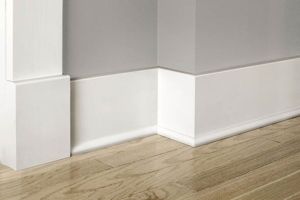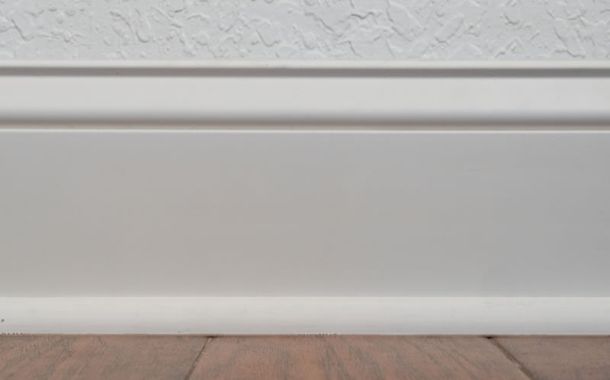How Much Does Baseboard Installation Cost?
Last Updated on January 27, 2024
Written by CPA Alec Pow | Content Reviewed by ![]() CFA Alexander Popinker
CFA Alexander Popinker
Installing new baseboards can transform the look of a room and significantly increase your home’s value. But how much does it actually cost to install baseboards? In this comprehensive guide, we’ll break down the key factors that impact baseboard installation cost and provide price ranges so you can budget for your next baseboard project.
Baseboards, also called base molding or floor molding, serve both practical and aesthetic purposes in home design. Along with protecting walls from damage, baseboards provide a finished look by cleanly transitioning between floors and walls. With endless options for materials and styles, they enable you to put your personal design stamp on a space.
How Much Does Baseboard Installation Cost?
While a DIY baseboard installation is possible, most homeowners opt to hire a professional carpenter or contractor. So what can you expect to pay? Here’s an overview of typical baseboard installation cost per linear foot:
- Labor: $3 to $8 per linear foot
- Materials: $1 to $20+ per linear foot
- Total cost range: $4 to $28+ per linear foot
According to Homewyse, the basic cost to install a baseboard is $8.02 – $11.80 per linear foot. For example, the cost for 132 linear feet of 2.25″ x 0.594″ oak ranch style base molding ranges from $314.78 to $474.84.
Bob Vila notes that the cost of baseboard installation is reported to range from $4.50 to $10 per linear foot.
A Houzz user reported receiving quotes for baseboard installation ranging from $1,500 to $3,000 for a total length of about 380 linear feet.
HomeServe writes that the cost of baseboard installation, including materials and labor, is reported to range from $720 to $1,300 per project nationwide.
The wide range reflects the many variables that affect your project budget…
Types of Baseboards and Their Costs
Baseboards come in a variety of materials, shapes, sizes, and finishes. The options you choose will significantly impact the material costs.
Wood baseboards are a popular choice made of oak, poplar, pine, and various other woods. The cost per linear foot is approximately:
- Pine: $1 to $4
- Poplar: $2 to $8
- Oak: $3 to $12
- Exotic woods: $8 to $20+
Vinyl baseboards are an affordable, low-maintenance option, ranging from $1 to $3 per linear foot. MDF (medium density fiberboard) baseboards have a smooth finish and cost $2 to $4 per foot.
For a truly custom look, decorative baseboards with detailed profiles and patterns can cost $4 to $20 per linear foot. These are often made of hardwoods like oak or poplar.
The material you choose will depend on your budget, style preferences and how much wear-and-tear the baseboards will need to handle.
Factors Impacting Total Baseboard Installation Cost
Aside from the baseboard materials, several other factors affect your total installation costs:
Size and Style
More intricate, heavier baseboard styles require more material and labor time, increasing costs. Simple, lightweight styles are the most affordable.
Linear Footage
The total length of baseboard needed directly impacts overall cost. Measure linear footage around the room perimeter to estimate.
Prep Work Required
If walls or floors need repairs, leveling, or painting beforehand, this adds to project costs.
DIY vs Professional Installation
Hiring a pro guarantees expertise but costs more in labor – $3 to $8 per linear foot. Doing it yourself saves significantly on labor but requires skills, tools, and time.
Accessories
transitions, corners, and caps add to material costs. Prefab inside and outside corners cost around $5 to $15 each.
Once you’ve selected your preferred baseboard type and style, you can estimate your total project range based on your required linear footage and accessories needed.
Be sure to get an itemized quote from professionals outlining labor, material, prep work, and accessory costs.
How to Choose the Right Baseboards
Beyond cost considerations, choose baseboards that coordinate with your home decor and design vision. Here are some tips:
Match architectural style. Choose traditional profiles like crown molding for formal spaces, or sleek, contemporary baseboards for modern spaces.
Complement moldings. If keeping existing crown molding, select baseboards that pair well in terms of size, style and finish.
Consider function. Baseboards take abuse in high-traffic areas. Opt for durable vinyl or wood species like oak in entryways or kids’ rooms.
Accent with color. Stained or painted baseboards can make a bold statement and coordinate with wall colors.
Create visual interest. Decorative styles add ornate detail for a high-end look.
Check proportions. Scale the size appropriately for the room. Higher ceilings suit taller baseboards.
Follow these guidelines, while keeping costs in mind, to select the ideal baseboards for your space and style.
Step-by-Step DIY Baseboard Installation
Installing baseboards yourself can result in significant cost savings compared to hiring a professional. If you’re up for a DIY project, follow these step-by-step instructions:
Gather Supplies
- Baseboard material
- Miter saw
- Table saw or circular saw
- Nail gun and compressor
- Hammer
- Finishing nails
- Wood glue
- Stud finder
- Level
- Paint/stain and supplies
Prep the Area
- Fill holes and imperfections in walls with spackle. Sand smooth.
- Vacuum and clear any debris from installation area.
- Paint or stain boards if desired. Allow drying time.
Cut Boards to Length
- Measure wall lengths and cut boards to size with a miter saw.
- For inside and outside corners, the miter cut the ends at 45-degree angles so they join cleanly.
Install Baseboards
- Pre-drill holes every 16 inches if nailing by hand. For a nail gun, every 24 inches.
- Apply a thin bead of wood glue to the backside.
- Nail baseboard to studs, not just drywall for durability.
- Use filler pieces around outlets; caulk small gaps if needed.
Finish Project
- Fill nail holes with wood filler, let dry, and sand smooth.
- Apply polyurethane for protection and sheen.
- Caulk along top edges and joints for a seamless look.
- Prime and paint baseboards if not pre-finished.
Follow these DIY steps carefully to ensure your baseboards are installed securely, properly, and looking polished.
Finding the Right Carpenter for Installation
 For those who would rather leave it to the professionals, hiring a qualified carpenter or contractor is key to getting quality results. Here are tips for finding the right pro:
For those who would rather leave it to the professionals, hiring a qualified carpenter or contractor is key to getting quality results. Here are tips for finding the right pro:
- Ask friends or neighbors for referrals.
- Search online reviews and check ratings on sites like HomeAdvisor or Angie’s List.
- Verify necessary licenses, insurance, and bonding.
- Ask about their baseboard installation experience and examples of past work.
- Get a detailed written estimate outlining preparation, materials, labor and finish work needed.
- Choose a pro who specializes in finish carpentry work like trim and baseboard installation.
Be sure to get multiple bids to find the best value. Reputable professionals will offer fair pricing and stand behind their workmanship.
Maintaining Baseboards
You might also like our articles about the cost of Acoustiblok, ceramic tile removal, or stretch ceiling installation.
Newly installed baseboards provide visual appeal, yet over time they’re prone to scuffs, paint splatters, and water damage. Follow these maintenance tips:
- Use painters tape when painting walls to prevent splatters.
- Dust frequently and clean with mild soap and water.
- Avoid excessive water exposure from mopping or leaks.
- Repair minor scratches with putty sticks that match the baseboard finish.
- Consider refinishing faded or damaged baseboards to restore their look.
With regular dusting and quick touch-ups when needed, you’ll keep baseboards looking like new for years.
Cost-Saving Tips for Your Project
Looking to cut costs on your baseboard installation or replacement project? Consider these money-saving options:
- Choose affordable materials like pine boards or vinyl rather than pricier hardwoods.
- Opt for simple baseboard styles that require less installation time.
- Paint or stain boards yourself prior to installation.
- Install baseboards yourself if you have the DIY skills.
- Look for baseboard deals at big box home improvement stores.
- Consider synthetic wood-look alternatives like PVC baseboards.
- Repurpose or refinish existing baseboards when feasible.
Prioritize essential areas first if the full project exceeds your budget. With smart planning, you can achieve beautiful baseboards on a budget.
Conclusion
Installing new baseboards is one of the most effective ways to elevate a room’s aesthetic. While costs vary based on materials, style, and installation factors, you can expect to invest $4 to $28+ per linear foot for this impactful home upgrade.
Carefully measure your space, select quality materials suited to your home’s style, and hire experienced installers when opting for professional installation. For a budget-friendly DIY route, follow the step-by-step guide outlined above.
With the right baseboard installation for your home, you’ll enjoy these beautiful finishes for years to come. Reach out to home improvement contractors for help assessing your options and getting accurate price quotes for your next baseboard project.
FAQ
How do you calculate baseboard installation?
To calculate total baseboard installation costs:
- Measure the linear footage needed around the perimeter of the room.
- Multiply the linear footage by the price per linear foot for materials. Add up prices for specialty trim pieces like corners.
- Multiply the linear footage by the labor price per linear foot.
- Add up the total materials cost and total labor cost for the grand total.
Get detailed per-foot pricing from contractors for accurate estimates. Remember to account for any additional preparatory or finish work needed too.
How much trim do I need for a 1500-square-foot house?
For a 1,500-square-foot house, you will need approximately 300 linear feet of baseboard trim, assuming 10-foot ceiling heights. To estimate your specific needs:
- Measure the perimeter of each room needing a new baseboard.
- Add up the total linear footage for all rooms.
- Add 10-20% extra for scrap pieces and mistakes.
Measure meticulously for an accurate estimate. Have 10-20% extra material on hand to allow for imperfect cuts and replacements down the road.
Is house trim expensive?
House trim like baseboards can range from inexpensive to expensive depending on the materials used. Basic vinyl and pine boards cost as little as $1 per linear foot. Prefinished oak can cost over $10 per foot, while premium woods like cherry can cost $20+ per foot.
Labor will range from $3 to $8 per linear foot for professional installation.
While real wood baseboards are more expensive, they add character and value. To save costs, choose simpler trim profiles that take less time to install. Primed boards are also cheaper, allowing you to paint later.
Consider your budget, home style, and long-term plans when investing in quality woodwork. Often a moderate upgrade pays off for aesthetics and durability.



Leave a Reply
Want to join the discussion?Feel free to contribute!